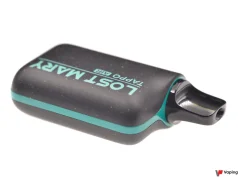
A few weeks ago, the pulmonologist Riccardo Polosa and his co-authors from the University of Catania, Italy, confirmed preliminary findings of health benefits by switching to electronic cigarettes for patients with asthma [1]. Contrasting with the optimism of the Italian team, a Greek consortium reported recently, in the proceedings of an international conference, immediate impairment among asthmatic patients [2], concluding that “vaping is not safe“.
More recently, an article first-authored by Davide Campagna from the University of Catania, Italy, and co-authored by Riccardo Polosa, among others, shows how a risk reduction practice may lead to health benefits for smokers who quit smoking by switching to e-cigarettes [3]. They critically address some of the concerns arising in relation to lung health, including respiratory infections and pneumonia.
Lung health concerns with e-cigarettes
The development of bronchiolitis obliterans (“popcorn lung”), initially associated to workers exposed to diacetyl, was regarded as a risk for vapers since some flavors used in e-liquids contain this chemical. However, no case has been reported in the medical literature in association to vaping.
Another lung infection, lipoid pneumonia, that is a rare disease occurring from aspiration or inhalation of fatlike material in the lung, may be another risk to vapers because of the quality of e-liquids. According to North American researchers, it is a major risk even if no such evidence has been reported in the medical literature so far. Such risk is unsubstantiated, according to the authors, because the the e-liquids do not contain nor generate fatlike material that may induce this type of pneumonia.
The aerosol of ultrafine particles produced by vaporisation of e-liquids may be responsible of secondhand vaping and affect the health of bystanders, as reported by many sources. Here again, the demonstration has been made that such volatile organic compounds (VOCs) do not represent a risk to bystanders since, by design, e-cigarettes do not generate side-stream emissions, as do the tobacco cigarettes. In addition the VOCs produced by e-cigarettes remain a few orders of magnitude lower compared to tobacco cigarette smoke and, in that sens, make the e-cigarette a healthier alternative to traditional ones.
Benefits and “collateral benefits”
With a 96% less harmful potential compared to traditional cigarette emissions, the e-cigarette is a risk reduction tool that may allow reducing daily cigarette consumption in smokers when switching to vaping products, conclude the authors. A risk reduction tool that is also likely to produce significant health benefits. They add that any residual risks will be “further diminished by adopting new technologies and applying quality and safety standards.”
The new technologies in this domain are “likely not only to further minimise residual health risks, but also to maximise health benefits”. The authors use the term of “collateral benefits” when describing the combined effect of the reduced tobacco consumption and the potential benefits provided by technological innovation.
The next steps
The authors recall that vaporizers will soon be regulated by the new Tobacco Products Directive (TPD), which mandates that the products are only placed on the market if the nicotine dose and uptake is reported on the unit packet and toxicological risk assessment is carried out on aerosol emissions.
They recommend future research to quantify the extent of achievable risk reduction when switching to regular vaping. The aims is to “consolidate the notion that smokers who quit smoking by switching to e-cigarettes can reverse harm from tobacco smoking in the lung”, a review conducted by Polosa himself [4]. They hope their work receive consideration by regulatory authorities seeking to adopt proportional measures for the e-vapour category.
[1] Polosa R., Morjaria J., Caponnetto P., Caruso M., Campagna D., Amaradio M.D., Ciampi G., Russo C. & Fisichella A., 2016. Persisting Long Term Benefits of Smoking Abstinence and Reduction in Asthmatic Smokers Who Have Switched to Electronic Cigarettes. Discov Med 21(114):99-108.
[2] Lappas A, Tzortzi A., Konstantinidi E., Tzavara C., Gennimata S., Koulouris N., Behrakis P., (2016). Immediate Effects of e-Cigarette Smoking in Healthy and Mild Asthmatic Young Smokers. Oral presentation, CHEST World Congress 2016, April 16 2016. DOI: 10.1016/j.chest.2016.02.616
[3] Campagna D., Amaradio M.D., Sands M.F., Polosa R., (2016). Respiratory infections and pneumonia: potential benefits of switching from smoking to vaping. Pneumonia, 8:4. DOI: 10.1186/s41479-016-0001-2
[4] Polosa R., (2015). Electronic cigarette use and harm reversal: emerging evidence in the lung. BMC Med. 2015;13:54. PMID:25857426. Doi:10.1186/s12916-015-0298-3












The reason “Popcorn Lung” is not associated with vaping is ONLY because it’s never called “Popcorn Lung” in regards to vaping .
The ONLY reason it was ever referred to as “popcorn lung” is because it happened in a popcorn factory .
Respiratory issues by vaping large amounts of e juice that contain diketones (the chemicals that are directly responsible for respiratory difficulties) medical professionals have claimed are classified as COPD symptoms and NOT “popcorn lung” .
These symptoms are very unlikely to be seen so soon with vaping , a decade or more will show the health consequences of vaping large amounts of juice that contain diketones .
Many juices contain considerably MORE diketones than that of real cigarettes and this has been documented .
Believing that most juice has much lower amounts is not correct.
Can you please provide sources for your claims regarding diketone content in ecigs vs real cigarettes? I’ve never heard this.
Diketones, if found will be in the juice one chooses not the e cig . Luckily there are many diketone free vendors out there these days so it’s each individuals choice on whether to vape juice containing diketones or not.
https://www.reddit.com/r/Deeper_DIY/comments/41t1q8/question_about_diketones/
your link has proven nothing.
LOL, thats because it was never meant to prove anything , there won’t be proof of anything either way for many years to come .
There is not a single article on the planet that “proves” anything , thats why these articles are laughable and nobody takes them seriously.
It takes many many years for things to show themselves and consuming large quantities of juice like vapors do these days with sub ohm and high wattage is in it’s infancy .
Wait a decade or more until vapors have many years of vaping large quantities of diketone loaded juices and then re evaluate .
Currently, the AFNOR norm is accounting for diacetyl in e-liquids. The minimum amount that is accepted is 22 micrograms per liter. This means that if more diacetyl is found in e-liquids, it must appear on the list of components so that people can have the choice to use this e-liquid or to turn to another product.
It is true that from cigalike use to subohm vaping, the amount of e-liquid consumed per day has considerably increased over the last few years. This goes together with the gradual decrease observed in e-liquid nicotine strength. Some brands even discarded the higher range of nicotine strengths to offer more of their products in the lower range, targeting subohm vapers.
The health issue associated with this change of behavior is an increase of exposure to the toxicants contained in the e-cigarette aerosol. Most of the calculations that have been made in scientific publications are based on a consumption of 4 ml per day. Experience tells us that DL inhalation leads to much higher daily consumption rates (12-30 ml) that are not yet documented.
Pretending that vaping is completely safe is nonsense. Compared to smoking, there is an obvious benefit of using this alternative to reduce tobacco consumption or to stop altogether. But what happens after the vaper gets rid of his last cigarettes depends on the pleasure that he/she takes with e-cigarettes and also raises awareness on the risk linked to long-term exposure.
Two vaper’s profiles are described:
– The ex-smoker who manages to wean off tobacco with the help of high nicotine strength e-cigarettes, who reduces nicotine strength gradually to a point where he/she stops using e-cigarettes altogether.
– The ex-smoker who switches to e-cigarette use, who reduces nicotine strength and compensates with higher consumption of e-liquid, who finds increasing pleasure in vaping and doesn’t express the will to stop.
The ideal case that is described first is associated with the lowest risk profile. Unfortunately, the second case is gaining popularity helped by the market offer, and is far from contributing to a relief in the pressure put by officials on this sector.
The regulatory issue that currently happens in the vaping sector is principally due to this dual aspect of the product: harm reduction tool vs consumer product.
Sorry to disappoint you but diketone free vendors will soon be the norm (And compulsory)
Disappoint are you kidding , i’m thrilled .
Cite your sources.
As intimated by your screen name, you must be high. lol Diacetyl is what bronchiolitis obliterans, otherwise known as popcorn lung, is blamed on and it’s found in tobacco, real butter, (if you fry with butter, you’re inhaling diacetyl) some butter flavorings, and some e-liquid flavorings with creamy or buttery notes. Most of the independent e-liquid flavoring manufacturers have removed, or are in the process of removing, it and the other diketones from their product.
In the Harvard study, the most diacetyl found was 238.9 ug in one Peach Schnapps flavored disposable cartridge, which makes it a product of Blu and tobacco company owned, by process of elimination. The rest ranged from LOD to 38.4 ug per cartridge. Each disposable cartridge holds approximately 1 mL of e-liquid, and on average vapers use around 4 – 5 mLs per day.
One particular study on the amount of diacetyl in cigarettes found between 250 and 361 ug (ppm and ug/mL are the same thing btw) in each cigarette from 6 products. The average number of cigarettes smoked is around 20 per day.
So, if we multiply even the lesser amount of diacetyl by the average number of cigarettes smoked, we get 5000 ug, while the highest amount of e-liquid diacetyl multiplied by the average e-liquid consumption is 1194.5 ug. That doesn’t take into account that most dedicated vapers don’t use Blu products, let alone the Blu peach schnapps flavor. Additionally, science has never been able to connect smoking to bronchiolitis obliterans, a disease that has nothing to do with COPD but is actually an inflammatory blockage of the lungs that leads to excessive scarring and hardening of the tissue.
http://ehp.niehs.nih.gov/wp-content/uploads/advpub/2015/12/ehp.1510185.acco.pdf
http://www.ncbi.nlm.nih.gov/pubmed/24635357
https://vaping.com/assets/uploads/docs/eliquidconsumption.png
http://www.ncbi.nlm.nih.gov/pmc/articles/PMC2762359/
http://www.sw.org/HealthLibrary?page=Bronchiolitis%20Obliterans
Please refrain from posting until you get a clue will you please . The fact that you posted info from studies known to be bogus says it all , c, mon man , are you serious , you believe that data LOL.
The biggest laugh by far though is your comment about companies weeding out juices that contain diketones , that is hilarious .
Unless you have individual testing results from EVERY e liquid manufacturer and you have recent data from an INDEPENDENT laboratory testing facility your talking out of your ass .
Just a few years ago it was proven that well over 70% of e liquid manufacturers were found to have diketones in their juices , even flavors from different categories for the same company had widely varying amounts .
The famous Five Pawns company had levels of diketone’s that FAR EXCEEDED the levels found in real cigarettes , bet you weren’t aware of that .
Since the e juice industry has exploded many believe the percentage of diketones being used in e juices today are higher than they have ever been in widely varying amounts .
Let me guess , your one of those types that think when an e juice retailer states on their website that they avoid diacetyl and other diketone’s in their e juices you can be sure they are telling the truth LOL.
Most of those claims are complete bullshit and if you probe a little more they will admit that they CANNOT guarantee it .
Many e jmanufacturers claim diketone free juice , for Gods sake , Five Pawns adamantly denied their juices had diketones and after testing independently (without their knowledge) it was proven to have some of the highest levels recorded from any e juice .
Lol you’re funny. And your proof is where? Oh yeah, that’s right…
Don’t mind me, I’ll just be over here listening to Eduard Khil.
Your comment below:
(Science has never been able to connect smoking to bronchiolitis obliterans)
You are aware that “Bronchial Obliterations” is rarely if ever diagnosed due the complexity and processes involved .
As far as that e juice consumption graph , do you realize how old that is lol, the “how much juice do you consume ” question that is asked these days on popular forums is completely different due to the popularity of sub ohm tank’s and high wattage vaping.
When laws come out that require e juice companies to be honest about what diketones are in their juices and how much then we can make some progress .
Problem is to this day there are no laws that require e juice companies to be truthful about what is in their juices, the “Five Pawns” lawsuit is evidence of exactly that problem .
They insisted their juices were free of diketones and as it turned out they were not being honest about it.
A lawsuit was brought forth by a bunch of customers because of their deception .
Since no law required them to be honest not much happened .
Have a good day Sir